MAN3246 Journal: Global HRM and Comparative Business Contexts
VerifiedAdded on 2022/04/14
|18
|3508
|26
Journal and Reflective Writing
AI Summary
This journal, written by Mervyn Mirshan Baskaran for the MAN3246 International and Comparative Human Resource Management module at the Australian College of Business and Technology, reflects on the first six lectures. It covers key aspects of global HRM, including adapting to global business, cultural differences, organizational context, and the localization of HRM practices. The journal delves into topics such as staffing for international assignments, training and development, performance management, compensation, and business etiquette. It explores the challenges of global operations, the importance of cultural awareness, and the impact of factors like dual-career spouses on international assignments. The author discusses selection criteria for international assignments, the significance of pre-departure training, and the role of cultural sensitivity in ensuring the success of expatriates. The journal also provides insights into the concept of equal employment opportunities, examining cultural and religious factors. The student references various scholars and real-world examples, such as HSBC and McDonald's, to support arguments and draw conclusions about the complexities of global HRM.
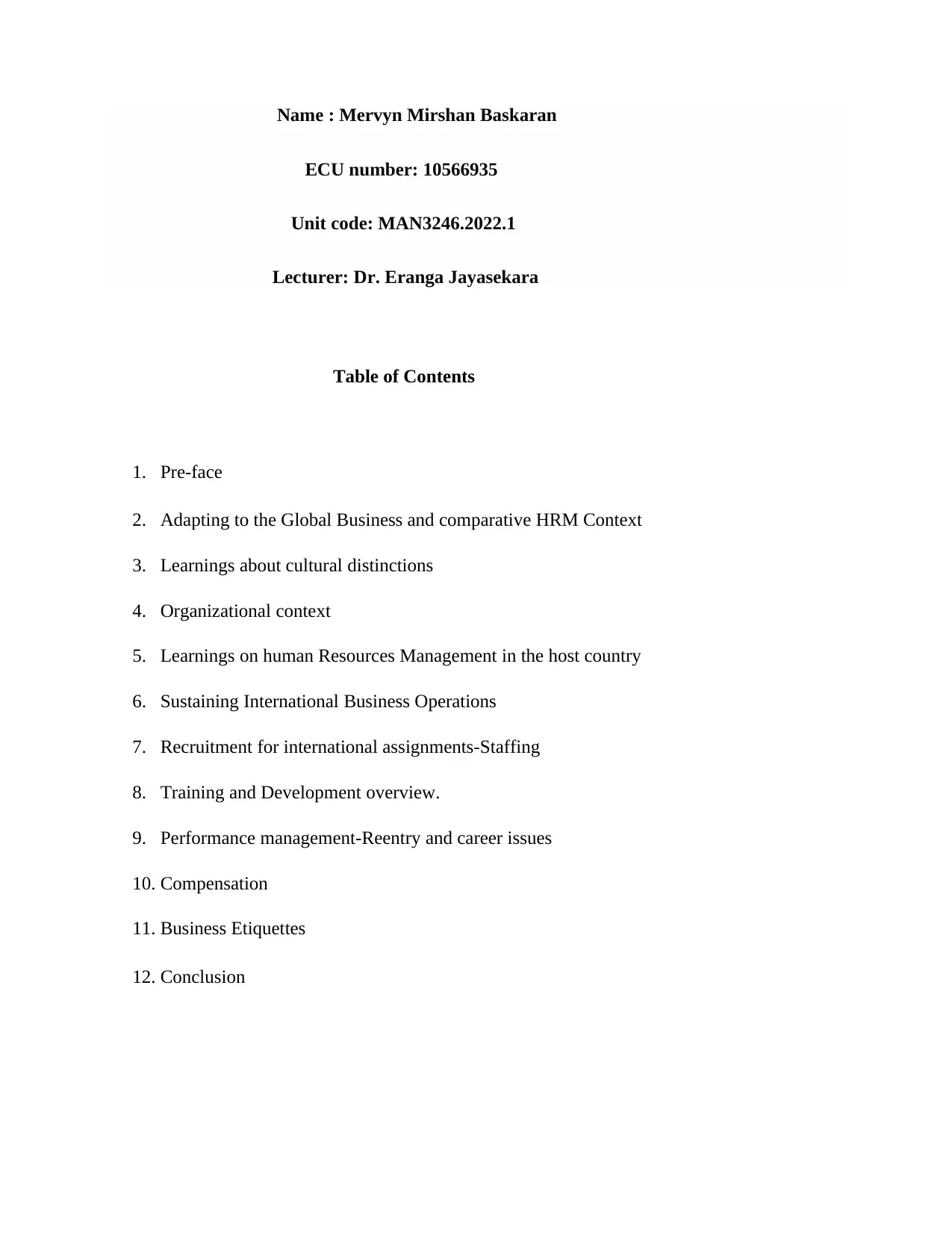
Name : Mervyn Mirshan Baskaran
ECU number: 10566935
Unit code: MAN3246.2022.1
Lecturer: Dr. Eranga Jayasekara
Table of Contents
1. Pre-face
2. Adapting to the Global Business and comparative HRM Context
3. Learnings about cultural distinctions
4. Organizational context
5. Learnings on human Resources Management in the host country
6. Sustaining International Business Operations
7. Recruitment for international assignments-Staffing
8. Training and Development overview.
9. Performance management-Reentry and career issues
10. Compensation
11. Business Etiquettes
12. Conclusion
ECU number: 10566935
Unit code: MAN3246.2022.1
Lecturer: Dr. Eranga Jayasekara
Table of Contents
1. Pre-face
2. Adapting to the Global Business and comparative HRM Context
3. Learnings about cultural distinctions
4. Organizational context
5. Learnings on human Resources Management in the host country
6. Sustaining International Business Operations
7. Recruitment for international assignments-Staffing
8. Training and Development overview.
9. Performance management-Reentry and career issues
10. Compensation
11. Business Etiquettes
12. Conclusion
Paraphrase This Document
Need a fresh take? Get an instant paraphrase of this document with our AI Paraphraser
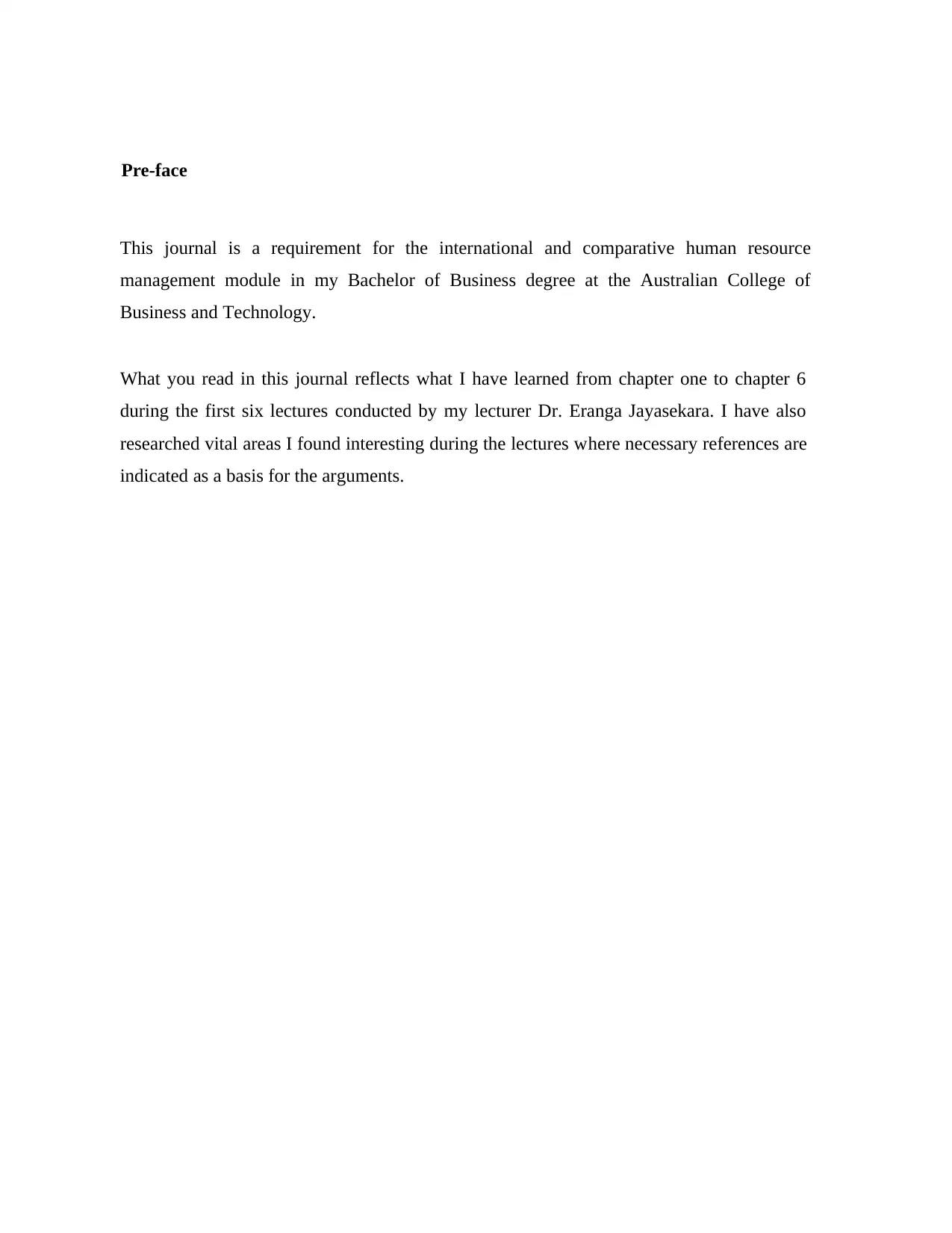
Pre-face
This journal is a requirement for the international and comparative human resource
management module in my Bachelor of Business degree at the Australian College of
Business and Technology.
What you read in this journal reflects what I have learned from chapter one to chapter 6
during the first six lectures conducted by my lecturer Dr. Eranga Jayasekara. I have also
researched vital areas I found interesting during the lectures where necessary references are
indicated as a basis for the arguments.
This journal is a requirement for the international and comparative human resource
management module in my Bachelor of Business degree at the Australian College of
Business and Technology.
What you read in this journal reflects what I have learned from chapter one to chapter 6
during the first six lectures conducted by my lecturer Dr. Eranga Jayasekara. I have also
researched vital areas I found interesting during the lectures where necessary references are
indicated as a basis for the arguments.
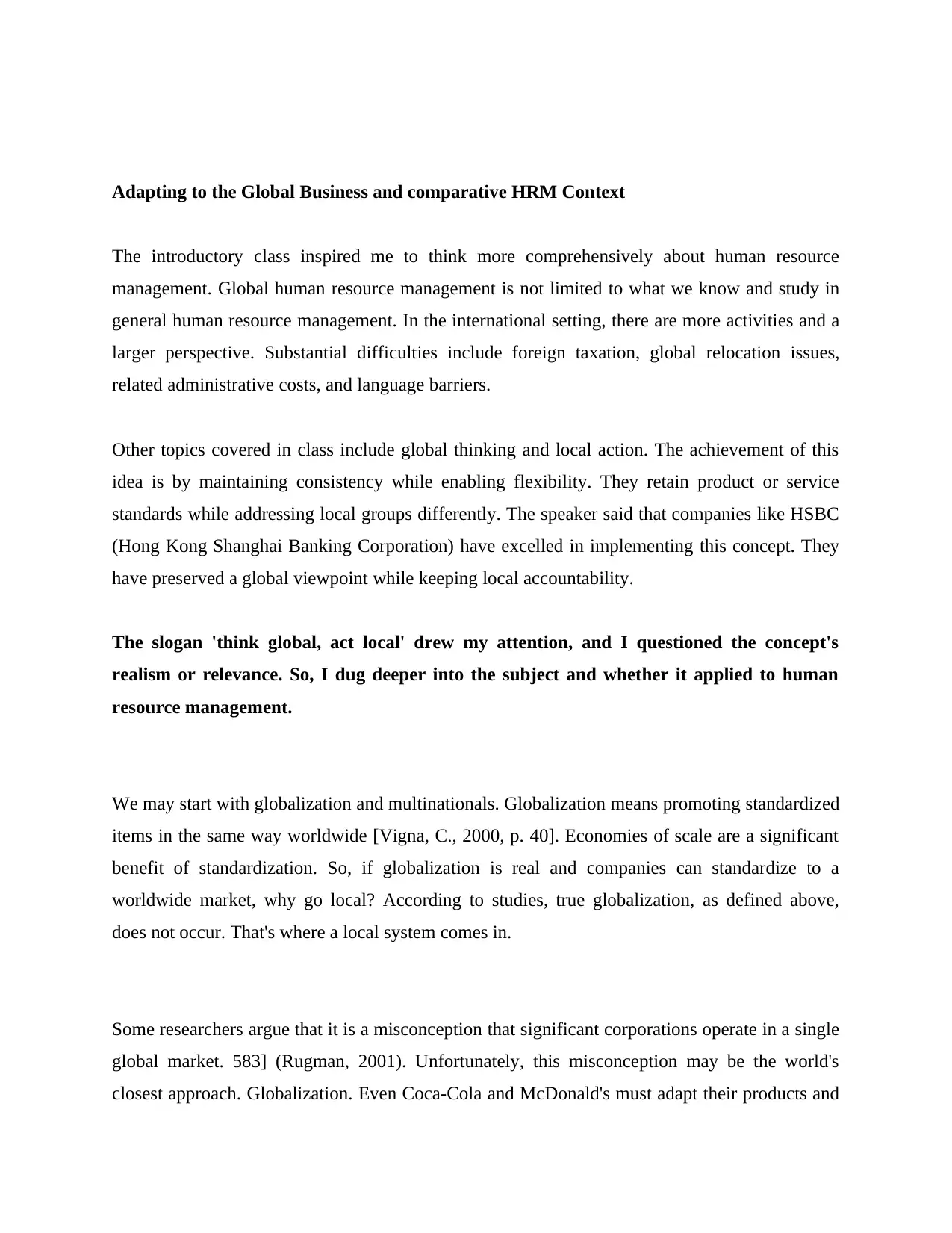
Adapting to the Global Business and comparative HRM Context
The introductory class inspired me to think more comprehensively about human resource
management. Global human resource management is not limited to what we know and study in
general human resource management. In the international setting, there are more activities and a
larger perspective. Substantial difficulties include foreign taxation, global relocation issues,
related administrative costs, and language barriers.
Other topics covered in class include global thinking and local action. The achievement of this
idea is by maintaining consistency while enabling flexibility. They retain product or service
standards while addressing local groups differently. The speaker said that companies like HSBC
(Hong Kong Shanghai Banking Corporation) have excelled in implementing this concept. They
have preserved a global viewpoint while keeping local accountability.
The slogan 'think global, act local' drew my attention, and I questioned the concept's
realism or relevance. So, I dug deeper into the subject and whether it applied to human
resource management.
We may start with globalization and multinationals. Globalization means promoting standardized
items in the same way worldwide [Vigna, C., 2000, p. 40]. Economies of scale are a significant
benefit of standardization. So, if globalization is real and companies can standardize to a
worldwide market, why go local? According to studies, true globalization, as defined above,
does not occur. That's where a local system comes in.
Some researchers argue that it is a misconception that significant corporations operate in a single
global market. 583] (Rugman, 2001). Unfortunately, this misconception may be the world's
closest approach. Globalization. Even Coca-Cola and McDonald's must adapt their products and
The introductory class inspired me to think more comprehensively about human resource
management. Global human resource management is not limited to what we know and study in
general human resource management. In the international setting, there are more activities and a
larger perspective. Substantial difficulties include foreign taxation, global relocation issues,
related administrative costs, and language barriers.
Other topics covered in class include global thinking and local action. The achievement of this
idea is by maintaining consistency while enabling flexibility. They retain product or service
standards while addressing local groups differently. The speaker said that companies like HSBC
(Hong Kong Shanghai Banking Corporation) have excelled in implementing this concept. They
have preserved a global viewpoint while keeping local accountability.
The slogan 'think global, act local' drew my attention, and I questioned the concept's
realism or relevance. So, I dug deeper into the subject and whether it applied to human
resource management.
We may start with globalization and multinationals. Globalization means promoting standardized
items in the same way worldwide [Vigna, C., 2000, p. 40]. Economies of scale are a significant
benefit of standardization. So, if globalization is real and companies can standardize to a
worldwide market, why go local? According to studies, true globalization, as defined above,
does not occur. That's where a local system comes in.
Some researchers argue that it is a misconception that significant corporations operate in a single
global market. 583] (Rugman, 2001). Unfortunately, this misconception may be the world's
closest approach. Globalization. Even Coca-Cola and McDonald's must adapt their products and
⊘ This is a preview!⊘
Do you want full access?
Subscribe today to unlock all pages.

Trusted by 1+ million students worldwide
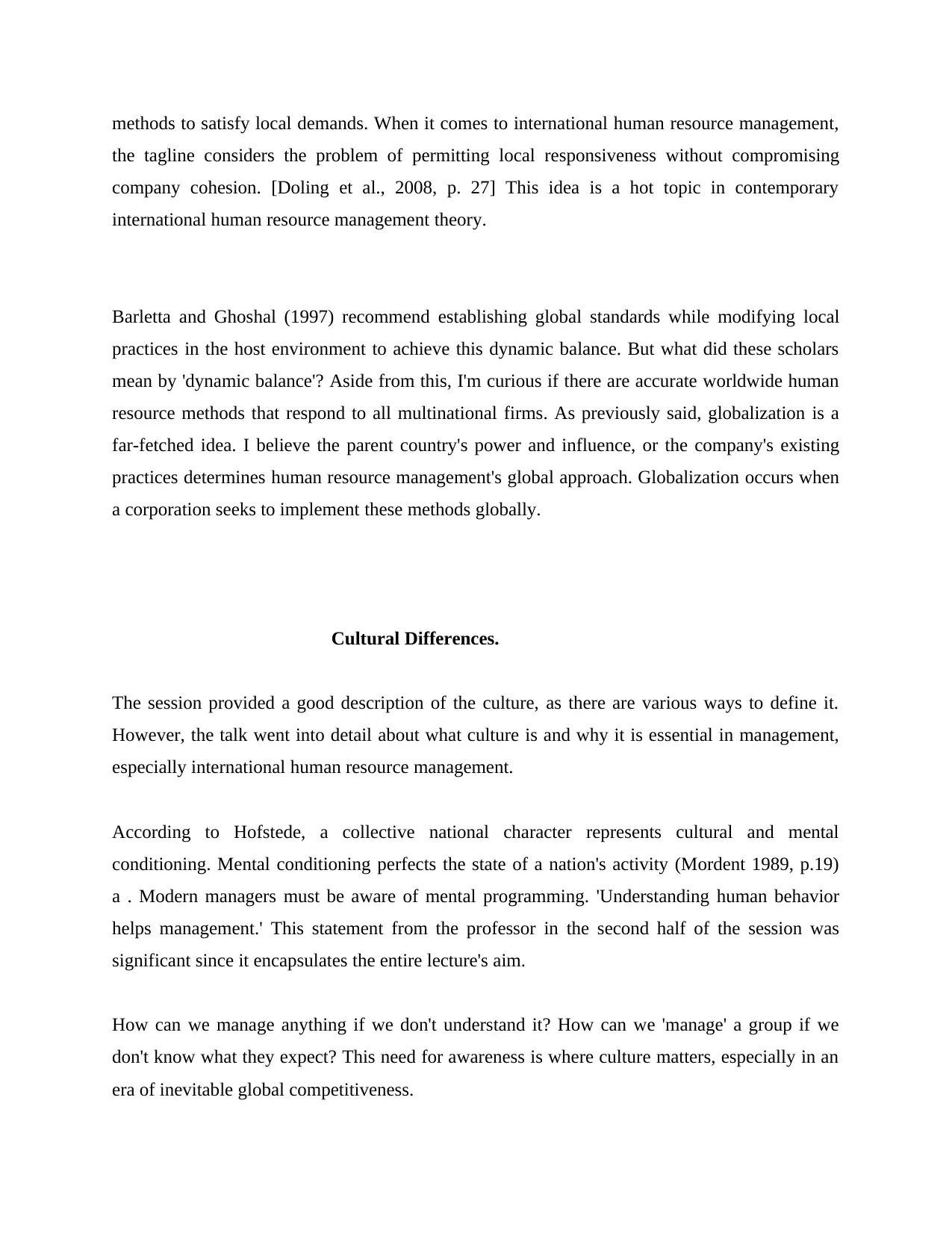
methods to satisfy local demands. When it comes to international human resource management,
the tagline considers the problem of permitting local responsiveness without compromising
company cohesion. [Doling et al., 2008, p. 27] This idea is a hot topic in contemporary
international human resource management theory.
Barletta and Ghoshal (1997) recommend establishing global standards while modifying local
practices in the host environment to achieve this dynamic balance. But what did these scholars
mean by 'dynamic balance'? Aside from this, I'm curious if there are accurate worldwide human
resource methods that respond to all multinational firms. As previously said, globalization is a
far-fetched idea. I believe the parent country's power and influence, or the company's existing
practices determines human resource management's global approach. Globalization occurs when
a corporation seeks to implement these methods globally.
Cultural Differences.
The session provided a good description of the culture, as there are various ways to define it.
However, the talk went into detail about what culture is and why it is essential in management,
especially international human resource management.
According to Hofstede, a collective national character represents cultural and mental
conditioning. Mental conditioning perfects the state of a nation's activity (Mordent 1989, p.19)
a . Modern managers must be aware of mental programming. 'Understanding human behavior
helps management.' This statement from the professor in the second half of the session was
significant since it encapsulates the entire lecture's aim.
How can we manage anything if we don't understand it? How can we 'manage' a group if we
don't know what they expect? This need for awareness is where culture matters, especially in an
era of inevitable global competitiveness.
the tagline considers the problem of permitting local responsiveness without compromising
company cohesion. [Doling et al., 2008, p. 27] This idea is a hot topic in contemporary
international human resource management theory.
Barletta and Ghoshal (1997) recommend establishing global standards while modifying local
practices in the host environment to achieve this dynamic balance. But what did these scholars
mean by 'dynamic balance'? Aside from this, I'm curious if there are accurate worldwide human
resource methods that respond to all multinational firms. As previously said, globalization is a
far-fetched idea. I believe the parent country's power and influence, or the company's existing
practices determines human resource management's global approach. Globalization occurs when
a corporation seeks to implement these methods globally.
Cultural Differences.
The session provided a good description of the culture, as there are various ways to define it.
However, the talk went into detail about what culture is and why it is essential in management,
especially international human resource management.
According to Hofstede, a collective national character represents cultural and mental
conditioning. Mental conditioning perfects the state of a nation's activity (Mordent 1989, p.19)
a . Modern managers must be aware of mental programming. 'Understanding human behavior
helps management.' This statement from the professor in the second half of the session was
significant since it encapsulates the entire lecture's aim.
How can we manage anything if we don't understand it? How can we 'manage' a group if we
don't know what they expect? This need for awareness is where culture matters, especially in an
era of inevitable global competitiveness.
Paraphrase This Document
Need a fresh take? Get an instant paraphrase of this document with our AI Paraphraser
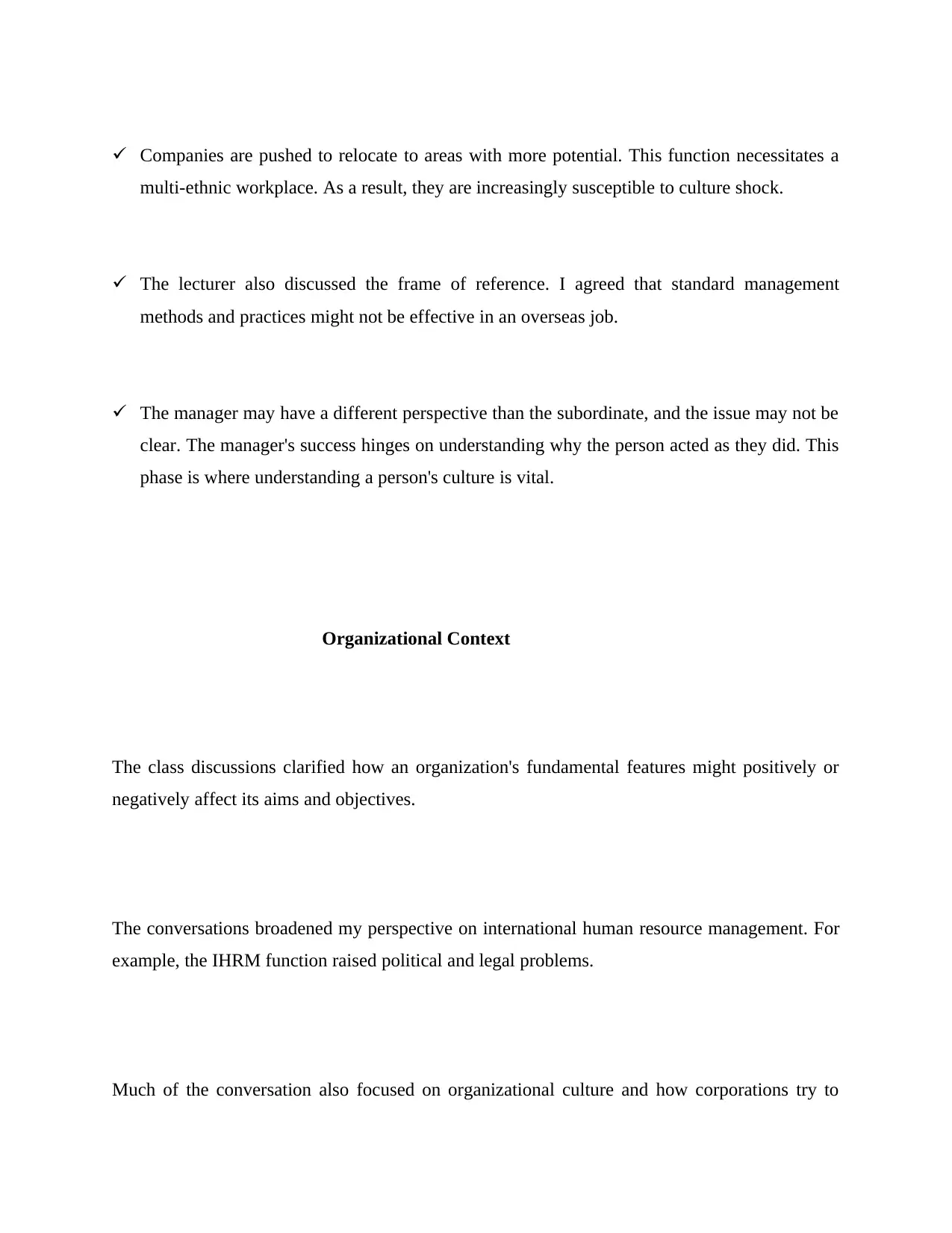
Companies are pushed to relocate to areas with more potential. This function necessitates a
multi-ethnic workplace. As a result, they are increasingly susceptible to culture shock.
The lecturer also discussed the frame of reference. I agreed that standard management
methods and practices might not be effective in an overseas job.
The manager may have a different perspective than the subordinate, and the issue may not be
clear. The manager's success hinges on understanding why the person acted as they did. This
phase is where understanding a person's culture is vital.
Organizational Context
The class discussions clarified how an organization's fundamental features might positively or
negatively affect its aims and objectives.
The conversations broadened my perspective on international human resource management. For
example, the IHRM function raised political and legal problems.
Much of the conversation also focused on organizational culture and how corporations try to
multi-ethnic workplace. As a result, they are increasingly susceptible to culture shock.
The lecturer also discussed the frame of reference. I agreed that standard management
methods and practices might not be effective in an overseas job.
The manager may have a different perspective than the subordinate, and the issue may not be
clear. The manager's success hinges on understanding why the person acted as they did. This
phase is where understanding a person's culture is vital.
Organizational Context
The class discussions clarified how an organization's fundamental features might positively or
negatively affect its aims and objectives.
The conversations broadened my perspective on international human resource management. For
example, the IHRM function raised political and legal problems.
Much of the conversation also focused on organizational culture and how corporations try to
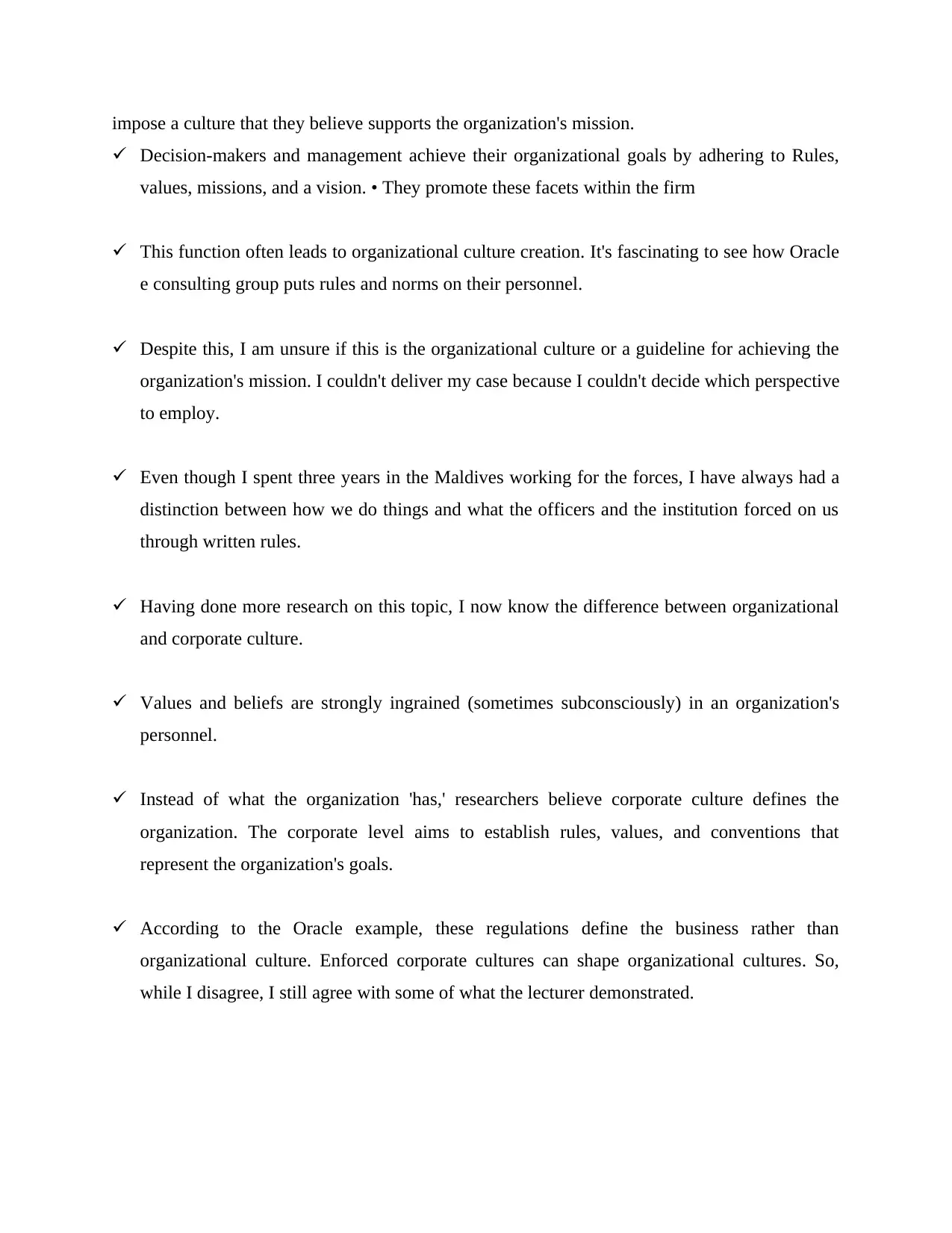
impose a culture that they believe supports the organization's mission.
Decision-makers and management achieve their organizational goals by adhering to Rules,
values, missions, and a vision. • They promote these facets within the firm
This function often leads to organizational culture creation. It's fascinating to see how Oracle
e consulting group puts rules and norms on their personnel.
Despite this, I am unsure if this is the organizational culture or a guideline for achieving the
organization's mission. I couldn't deliver my case because I couldn't decide which perspective
to employ.
Even though I spent three years in the Maldives working for the forces, I have always had a
distinction between how we do things and what the officers and the institution forced on us
through written rules.
Having done more research on this topic, I now know the difference between organizational
and corporate culture.
Values and beliefs are strongly ingrained (sometimes subconsciously) in an organization's
personnel.
Instead of what the organization 'has,' researchers believe corporate culture defines the
organization. The corporate level aims to establish rules, values, and conventions that
represent the organization's goals.
According to the Oracle example, these regulations define the business rather than
organizational culture. Enforced corporate cultures can shape organizational cultures. So,
while I disagree, I still agree with some of what the lecturer demonstrated.
Decision-makers and management achieve their organizational goals by adhering to Rules,
values, missions, and a vision. • They promote these facets within the firm
This function often leads to organizational culture creation. It's fascinating to see how Oracle
e consulting group puts rules and norms on their personnel.
Despite this, I am unsure if this is the organizational culture or a guideline for achieving the
organization's mission. I couldn't deliver my case because I couldn't decide which perspective
to employ.
Even though I spent three years in the Maldives working for the forces, I have always had a
distinction between how we do things and what the officers and the institution forced on us
through written rules.
Having done more research on this topic, I now know the difference between organizational
and corporate culture.
Values and beliefs are strongly ingrained (sometimes subconsciously) in an organization's
personnel.
Instead of what the organization 'has,' researchers believe corporate culture defines the
organization. The corporate level aims to establish rules, values, and conventions that
represent the organization's goals.
According to the Oracle example, these regulations define the business rather than
organizational culture. Enforced corporate cultures can shape organizational cultures. So,
while I disagree, I still agree with some of what the lecturer demonstrated.
⊘ This is a preview!⊘
Do you want full access?
Subscribe today to unlock all pages.

Trusted by 1+ million students worldwide
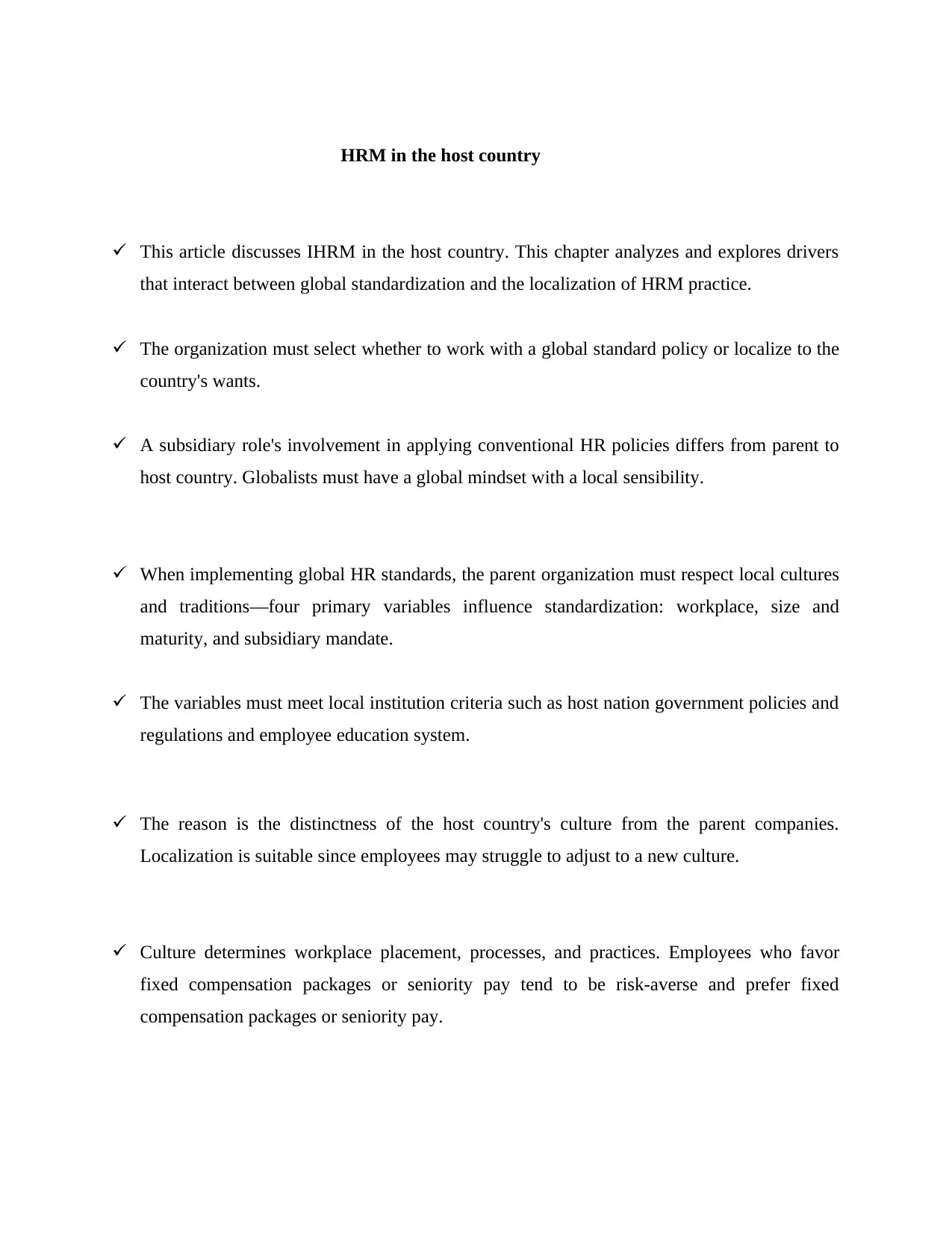
HRM in the host country
This article discusses IHRM in the host country. This chapter analyzes and explores drivers
that interact between global standardization and the localization of HRM practice.
The organization must select whether to work with a global standard policy or localize to the
country's wants.
A subsidiary role's involvement in applying conventional HR policies differs from parent to
host country. Globalists must have a global mindset with a local sensibility.
When implementing global HR standards, the parent organization must respect local cultures
and traditions—four primary variables influence standardization: workplace, size and
maturity, and subsidiary mandate.
The variables must meet local institution criteria such as host nation government policies and
regulations and employee education system.
The reason is the distinctness of the host country's culture from the parent companies.
Localization is suitable since employees may struggle to adjust to a new culture.
Culture determines workplace placement, processes, and practices. Employees who favor
fixed compensation packages or seniority pay tend to be risk-averse and prefer fixed
compensation packages or seniority pay.
This article discusses IHRM in the host country. This chapter analyzes and explores drivers
that interact between global standardization and the localization of HRM practice.
The organization must select whether to work with a global standard policy or localize to the
country's wants.
A subsidiary role's involvement in applying conventional HR policies differs from parent to
host country. Globalists must have a global mindset with a local sensibility.
When implementing global HR standards, the parent organization must respect local cultures
and traditions—four primary variables influence standardization: workplace, size and
maturity, and subsidiary mandate.
The variables must meet local institution criteria such as host nation government policies and
regulations and employee education system.
The reason is the distinctness of the host country's culture from the parent companies.
Localization is suitable since employees may struggle to adjust to a new culture.
Culture determines workplace placement, processes, and practices. Employees who favor
fixed compensation packages or seniority pay tend to be risk-averse and prefer fixed
compensation packages or seniority pay.
Paraphrase This Document
Need a fresh take? Get an instant paraphrase of this document with our AI Paraphraser
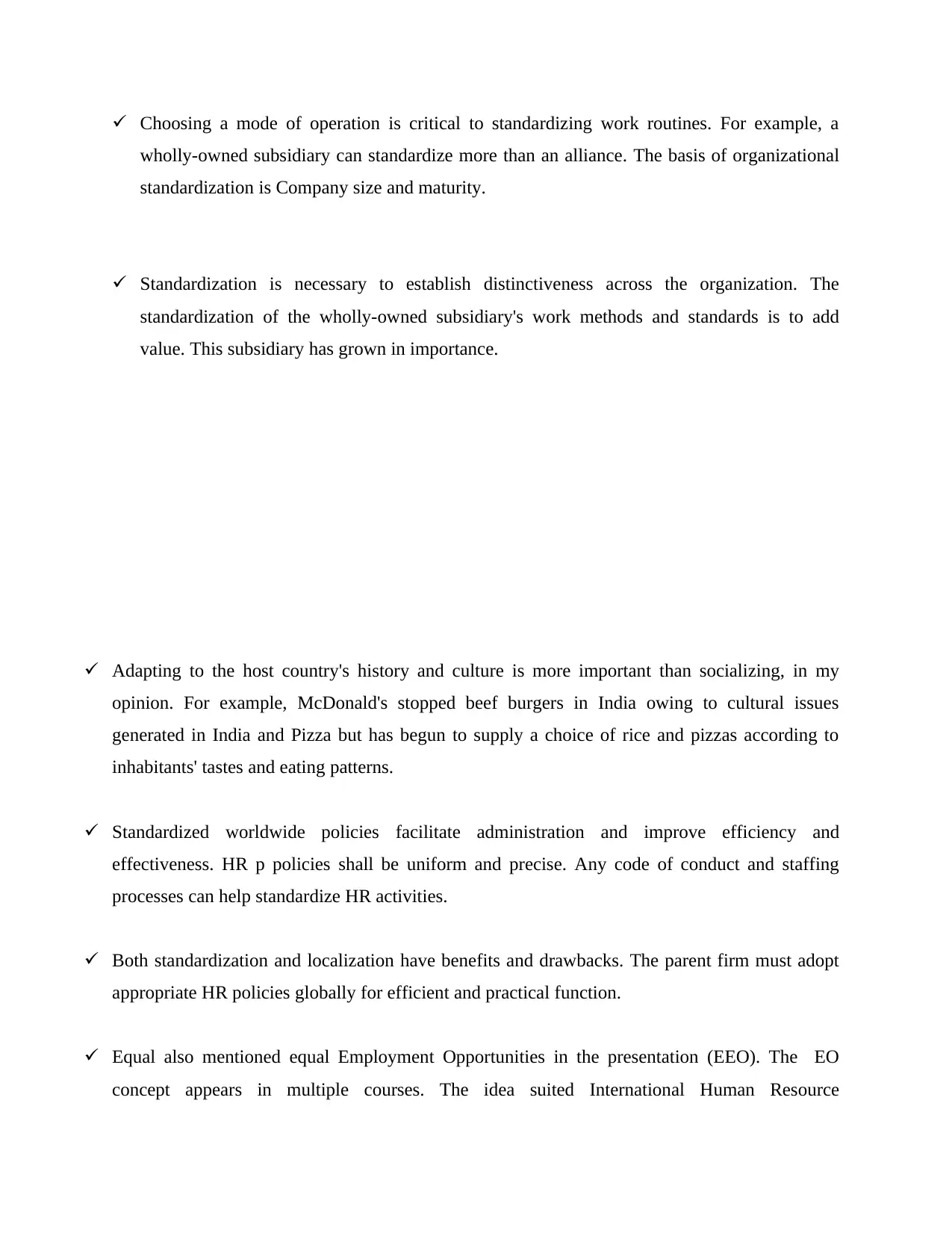
Choosing a mode of operation is critical to standardizing work routines. For example, a
wholly-owned subsidiary can standardize more than an alliance. The basis of organizational
standardization is Company size and maturity.
Standardization is necessary to establish distinctiveness across the organization. The
standardization of the wholly-owned subsidiary's work methods and standards is to add
value. This subsidiary has grown in importance.
Adapting to the host country's history and culture is more important than socializing, in my
opinion. For example, McDonald's stopped beef burgers in India owing to cultural issues
generated in India and Pizza but has begun to supply a choice of rice and pizzas according to
inhabitants' tastes and eating patterns.
Standardized worldwide policies facilitate administration and improve efficiency and
effectiveness. HR p policies shall be uniform and precise. Any code of conduct and staffing
processes can help standardize HR activities.
Both standardization and localization have benefits and drawbacks. The parent firm must adopt
appropriate HR policies globally for efficient and practical function.
Equal also mentioned equal Employment Opportunities in the presentation (EEO). The EO
concept appears in multiple courses. The idea suited International Human Resource
wholly-owned subsidiary can standardize more than an alliance. The basis of organizational
standardization is Company size and maturity.
Standardization is necessary to establish distinctiveness across the organization. The
standardization of the wholly-owned subsidiary's work methods and standards is to add
value. This subsidiary has grown in importance.
Adapting to the host country's history and culture is more important than socializing, in my
opinion. For example, McDonald's stopped beef burgers in India owing to cultural issues
generated in India and Pizza but has begun to supply a choice of rice and pizzas according to
inhabitants' tastes and eating patterns.
Standardized worldwide policies facilitate administration and improve efficiency and
effectiveness. HR p policies shall be uniform and precise. Any code of conduct and staffing
processes can help standardize HR activities.
Both standardization and localization have benefits and drawbacks. The parent firm must adopt
appropriate HR policies globally for efficient and practical function.
Equal also mentioned equal Employment Opportunities in the presentation (EEO). The EO
concept appears in multiple courses. The idea suited International Human Resource
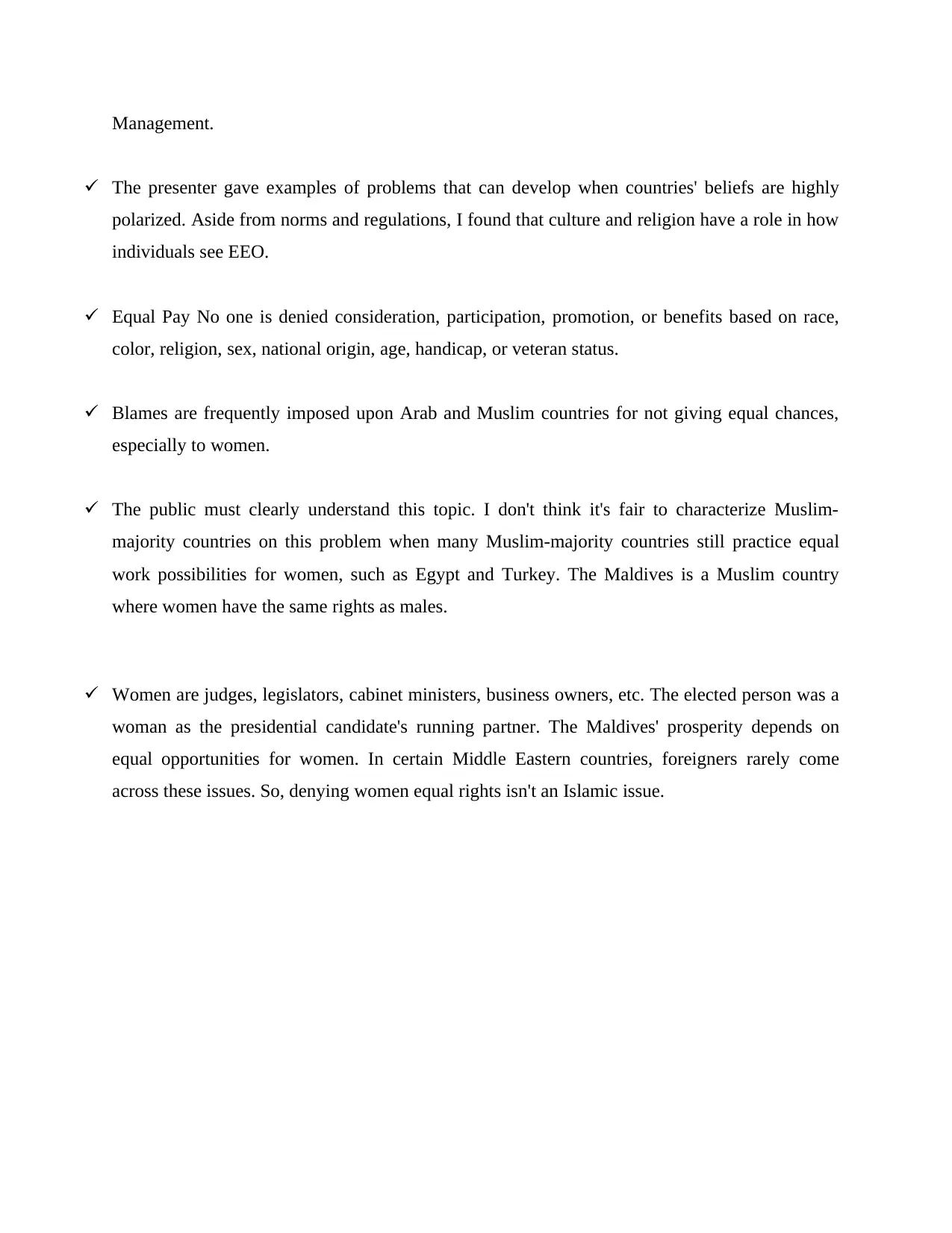
Management.
The presenter gave examples of problems that can develop when countries' beliefs are highly
polarized. Aside from norms and regulations, I found that culture and religion have a role in how
individuals see EEO.
Equal Pay No one is denied consideration, participation, promotion, or benefits based on race,
color, religion, sex, national origin, age, handicap, or veteran status.
Blames are frequently imposed upon Arab and Muslim countries for not giving equal chances,
especially to women.
The public must clearly understand this topic. I don't think it's fair to characterize Muslim-
majority countries on this problem when many Muslim-majority countries still practice equal
work possibilities for women, such as Egypt and Turkey. The Maldives is a Muslim country
where women have the same rights as males.
Women are judges, legislators, cabinet ministers, business owners, etc. The elected person was a
woman as the presidential candidate's running partner. The Maldives' prosperity depends on
equal opportunities for women. In certain Middle Eastern countries, foreigners rarely come
across these issues. So, denying women equal rights isn't an Islamic issue.
The presenter gave examples of problems that can develop when countries' beliefs are highly
polarized. Aside from norms and regulations, I found that culture and religion have a role in how
individuals see EEO.
Equal Pay No one is denied consideration, participation, promotion, or benefits based on race,
color, religion, sex, national origin, age, handicap, or veteran status.
Blames are frequently imposed upon Arab and Muslim countries for not giving equal chances,
especially to women.
The public must clearly understand this topic. I don't think it's fair to characterize Muslim-
majority countries on this problem when many Muslim-majority countries still practice equal
work possibilities for women, such as Egypt and Turkey. The Maldives is a Muslim country
where women have the same rights as males.
Women are judges, legislators, cabinet ministers, business owners, etc. The elected person was a
woman as the presidential candidate's running partner. The Maldives' prosperity depends on
equal opportunities for women. In certain Middle Eastern countries, foreigners rarely come
across these issues. So, denying women equal rights isn't an Islamic issue.
⊘ This is a preview!⊘
Do you want full access?
Subscribe today to unlock all pages.

Trusted by 1+ million students worldwide
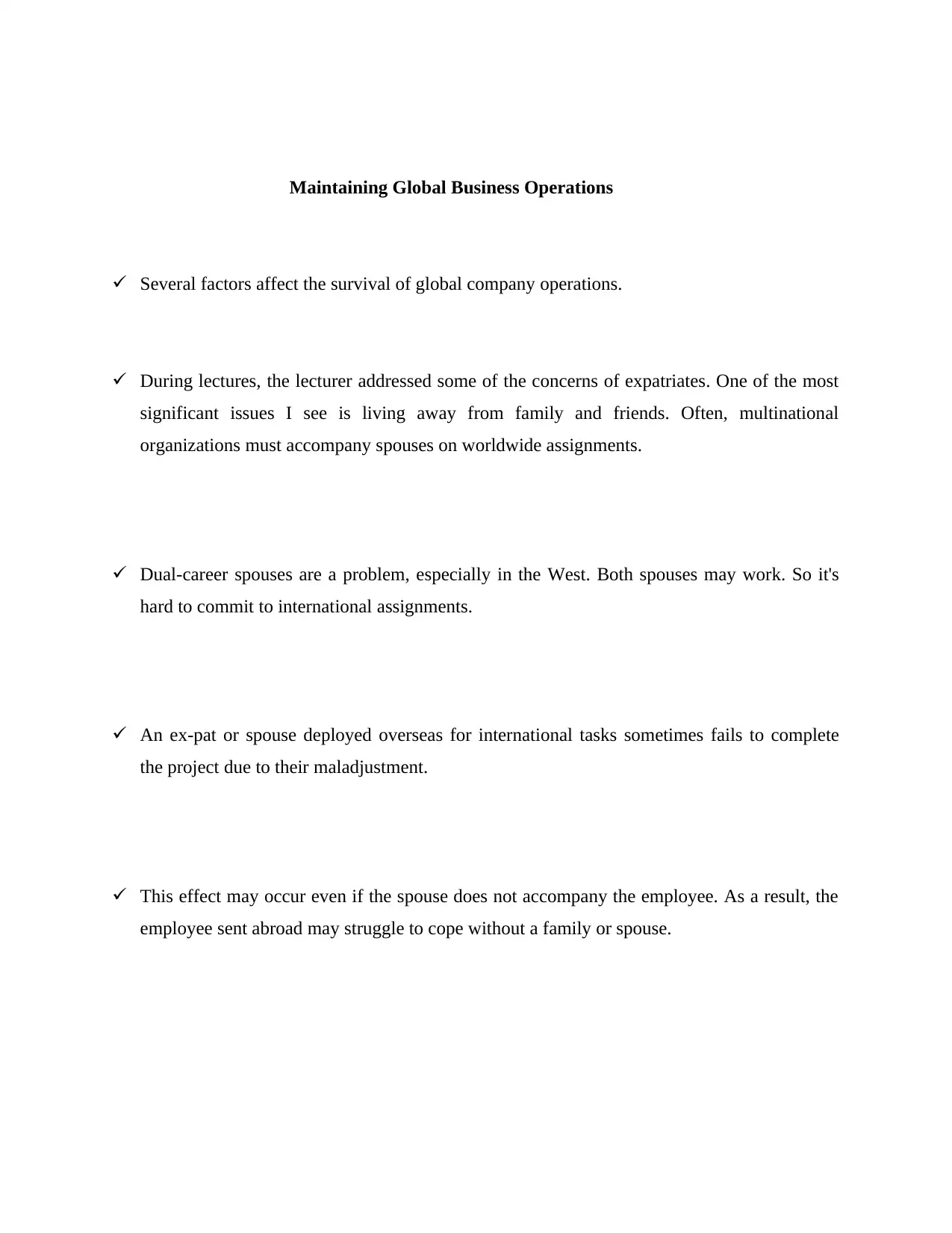
Maintaining Global Business Operations
Several factors affect the survival of global company operations.
During lectures, the lecturer addressed some of the concerns of expatriates. One of the most
significant issues I see is living away from family and friends. Often, multinational
organizations must accompany spouses on worldwide assignments.
Dual-career spouses are a problem, especially in the West. Both spouses may work. So it's
hard to commit to international assignments.
An ex-pat or spouse deployed overseas for international tasks sometimes fails to complete
the project due to their maladjustment.
This effect may occur even if the spouse does not accompany the employee. As a result, the
employee sent abroad may struggle to cope without a family or spouse.
Several factors affect the survival of global company operations.
During lectures, the lecturer addressed some of the concerns of expatriates. One of the most
significant issues I see is living away from family and friends. Often, multinational
organizations must accompany spouses on worldwide assignments.
Dual-career spouses are a problem, especially in the West. Both spouses may work. So it's
hard to commit to international assignments.
An ex-pat or spouse deployed overseas for international tasks sometimes fails to complete
the project due to their maladjustment.
This effect may occur even if the spouse does not accompany the employee. As a result, the
employee sent abroad may struggle to cope without a family or spouse.
Paraphrase This Document
Need a fresh take? Get an instant paraphrase of this document with our AI Paraphraser
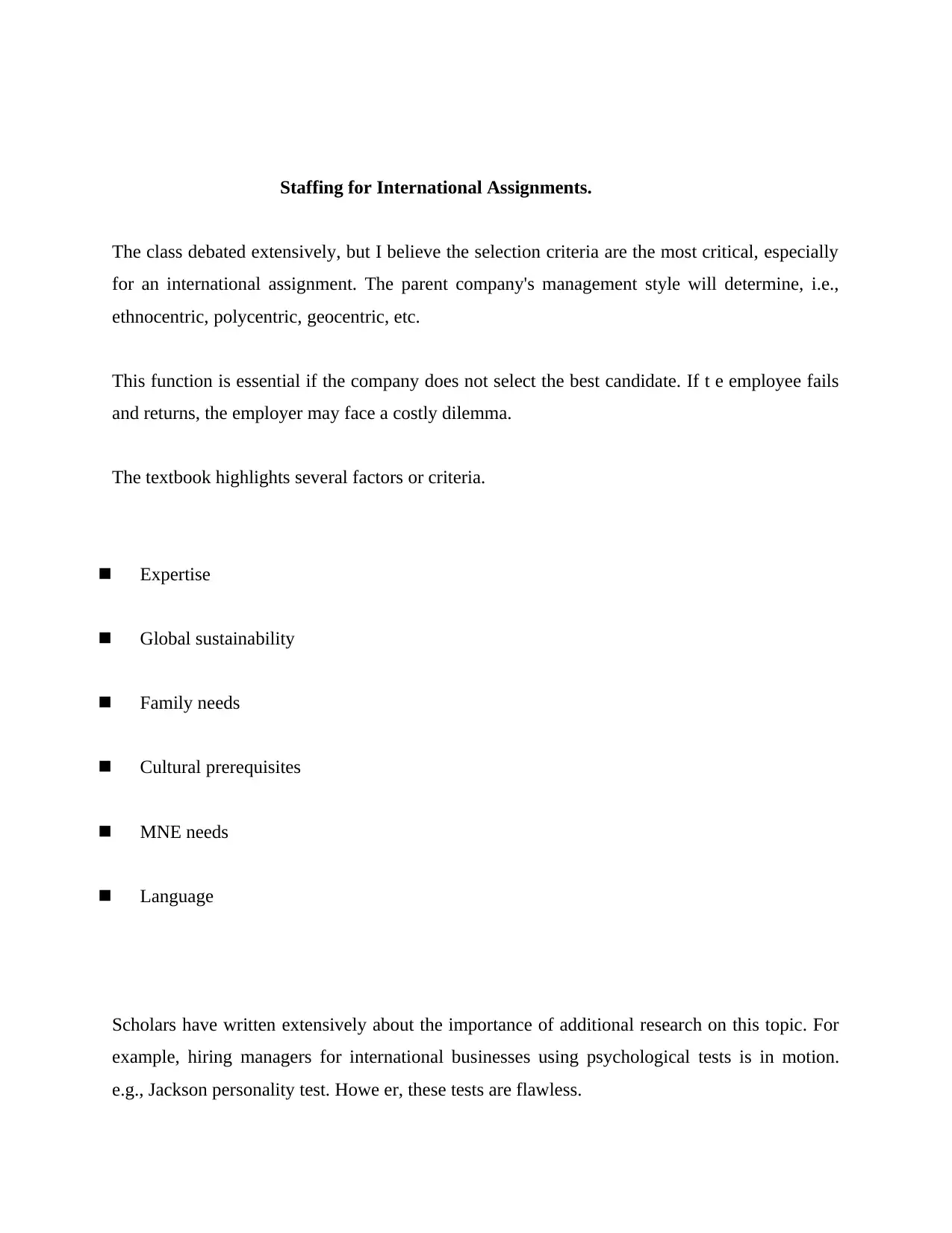
Staffing for International Assignments.
The class debated extensively, but I believe the selection criteria are the most critical, especially
for an international assignment. The parent company's management style will determine, i.e.,
ethnocentric, polycentric, geocentric, etc.
This function is essential if the company does not select the best candidate. If t e employee fails
and returns, the employer may face a costly dilemma.
The textbook highlights several factors or criteria.
Expertise
Global sustainability
Family needs
Cultural prerequisites
MNE needs
Language
Scholars have written extensively about the importance of additional research on this topic. For
example, hiring managers for international businesses using psychological tests is in motion.
e.g., Jackson personality test. Howe er, these tests are flawless.
The class debated extensively, but I believe the selection criteria are the most critical, especially
for an international assignment. The parent company's management style will determine, i.e.,
ethnocentric, polycentric, geocentric, etc.
This function is essential if the company does not select the best candidate. If t e employee fails
and returns, the employer may face a costly dilemma.
The textbook highlights several factors or criteria.
Expertise
Global sustainability
Family needs
Cultural prerequisites
MNE needs
Language
Scholars have written extensively about the importance of additional research on this topic. For
example, hiring managers for international businesses using psychological tests is in motion.
e.g., Jackson personality test. Howe er, these tests are flawless.
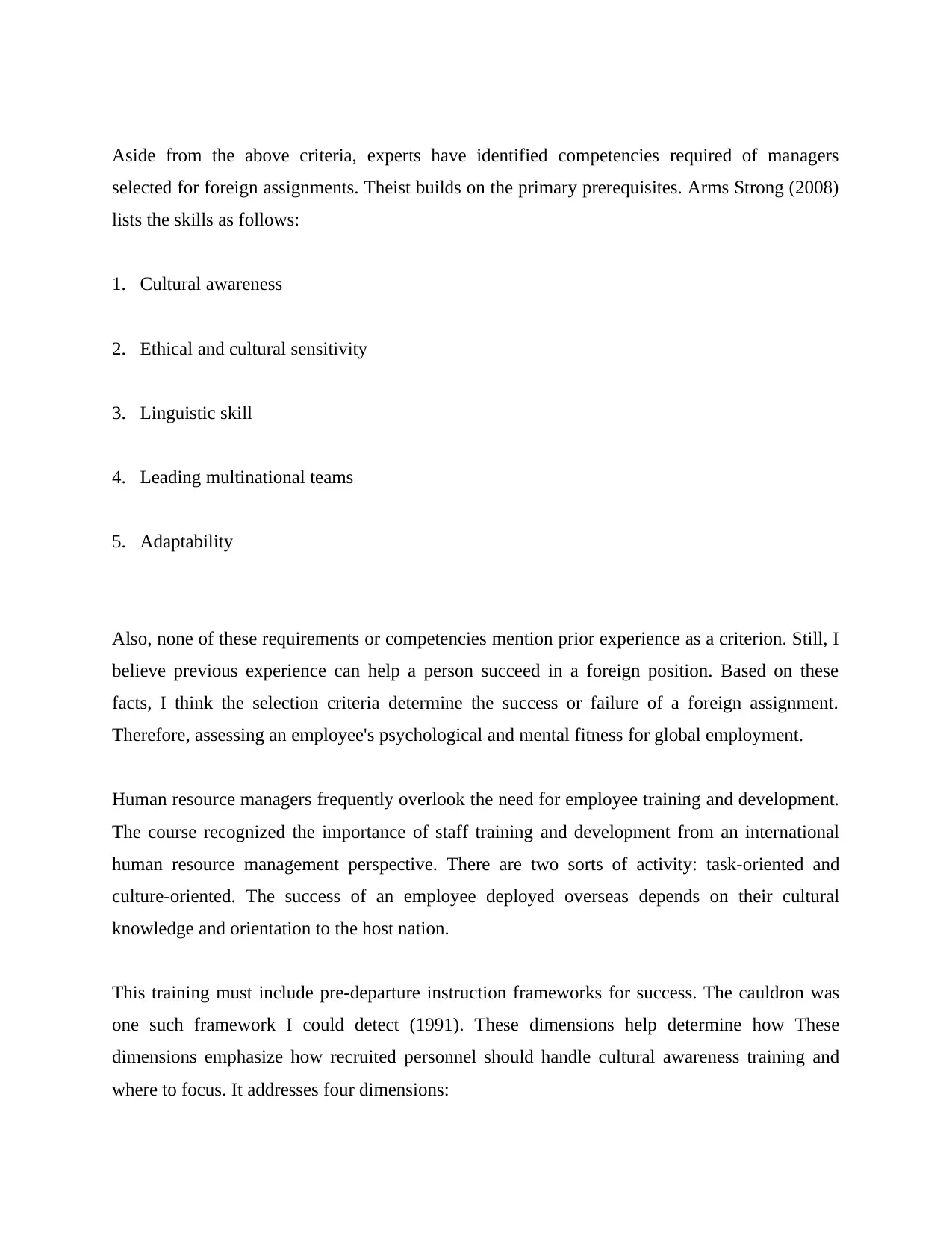
Aside from the above criteria, experts have identified competencies required of managers
selected for foreign assignments. Theist builds on the primary prerequisites. Arms Strong (2008)
lists the skills as follows:
1. Cultural awareness
2. Ethical and cultural sensitivity
3. Linguistic skill
4. Leading multinational teams
5. Adaptability
Also, none of these requirements or competencies mention prior experience as a criterion. Still, I
believe previous experience can help a person succeed in a foreign position. Based on these
facts, I think the selection criteria determine the success or failure of a foreign assignment.
Therefore, assessing an employee's psychological and mental fitness for global employment.
Human resource managers frequently overlook the need for employee training and development.
The course recognized the importance of staff training and development from an international
human resource management perspective. There are two sorts of activity: task-oriented and
culture-oriented. The success of an employee deployed overseas depends on their cultural
knowledge and orientation to the host nation.
This training must include pre-departure instruction frameworks for success. The cauldron was
one such framework I could detect (1991). These dimensions help determine how These
dimensions emphasize how recruited personnel should handle cultural awareness training and
where to focus. It addresses four dimensions:
selected for foreign assignments. Theist builds on the primary prerequisites. Arms Strong (2008)
lists the skills as follows:
1. Cultural awareness
2. Ethical and cultural sensitivity
3. Linguistic skill
4. Leading multinational teams
5. Adaptability
Also, none of these requirements or competencies mention prior experience as a criterion. Still, I
believe previous experience can help a person succeed in a foreign position. Based on these
facts, I think the selection criteria determine the success or failure of a foreign assignment.
Therefore, assessing an employee's psychological and mental fitness for global employment.
Human resource managers frequently overlook the need for employee training and development.
The course recognized the importance of staff training and development from an international
human resource management perspective. There are two sorts of activity: task-oriented and
culture-oriented. The success of an employee deployed overseas depends on their cultural
knowledge and orientation to the host nation.
This training must include pre-departure instruction frameworks for success. The cauldron was
one such framework I could detect (1991). These dimensions help determine how These
dimensions emphasize how recruited personnel should handle cultural awareness training and
where to focus. It addresses four dimensions:
⊘ This is a preview!⊘
Do you want full access?
Subscribe today to unlock all pages.

Trusted by 1+ million students worldwide
1 out of 18
Related Documents
Your All-in-One AI-Powered Toolkit for Academic Success.
+13062052269
info@desklib.com
Available 24*7 on WhatsApp / Email
![[object Object]](/_next/static/media/star-bottom.7253800d.svg)
Unlock your academic potential
Copyright © 2020–2025 A2Z Services. All Rights Reserved. Developed and managed by ZUCOL.




